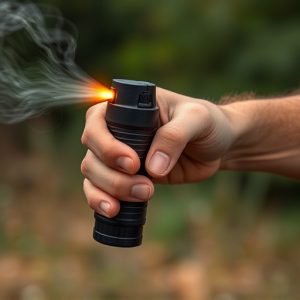Pepper Spray for Civilians: Deployment, Storage, and Legal Insights
Storing pepper spray while traveling requires understanding local laws, adhering to TSA guidelines,…….
Storing pepper spray while traveling requires understanding local laws, adhering to TSA guidelines, and prioritizing safety. Keep it cool, dry, away from sunlight, and out of reach of children in secure locations. For travel, opt for compact, easy-to-open mechanisms. Regularly check expiration dates. Deploy effectively by targeting facial areas in close quarters. Ensure storage containers withstand temperature changes and physical impacts to maintain functionality.
“In an era where civil protection and personal safety are paramount, understanding the power of inflammatory spray has become essential. This versatile tool offers a non-lethal means of deterring potential threats, making it a popular choice for civilians seeking self-defense. From its active ingredients to its impact on human physiology, this article explores the science behind pepper spray. We’ll navigate legal frameworks, providing insights into responsible carrying practices and storage solutions, including expert tips for safe keeping while traveling. Get ready to discover effective deployment techniques that could make all the difference in civil situations.”
- Understanding Pepper Spray: Its Composition and Efficacy in Civil Protection
- Legal Considerations and Regulations for Carrying Pepper Spray Publicly
- Storing Pepper Spray Safely: Tips for Travel and Long-Term Use
- Effective Deployment Techniques: Maximizing Pepper Spray's Impact in Civil Situations
Understanding Pepper Spray: Its Composition and Efficacy in Civil Protection
Pepper spray, also known as oleoresin capsicum (OC) spray, is a non-lethal self-defense tool that has become increasingly popular for civilian protection. Its primary active ingredient is capsaicin, the same compound that gives chili peppers their heat and irritation properties. When sprayed onto the eyes and face, capsaicin triggers a burning sensation, causing the target to temporarily blur their vision, cough, and experience pain, providing enough time for the user to escape or deter an attacker.
The effectiveness of pepper spray lies in its ability to disrupt an assailant’s balance and coordination, enabling the user to gain distance or summon help. However, proper storage while traveling is essential to maintain its potency. Pepper sprays are sensitive to heat and light, so it’s crucial to keep them in a cool, dry place, away from direct sunlight. Many travel-sized pepper spray cans have built-in protective features, such as heat-activated mechanisms, to preserve their effectiveness. Always check local regulations regarding the carriage of pepper spray when traveling, ensuring compliance with airport or border control policies.
Legal Considerations and Regulations for Carrying Pepper Spray Publicly
When considering the public carrying of pepper spray for personal protection, it’s crucial to understand the legal landscape and regulations that govern its use. The laws surrounding pepper spray vary greatly by region, with some areas permitting its open carry while others restrict it to concealed possession only. Additionally, there are often specific guidelines regarding the type and capacity of the spray allowed, as well as age restrictions on purchasing and carrying.
Storing pepper spray while traveling adds another layer of consideration. Federal Transportation Security Administration (TSA) regulations permit passengers to carry a limited quantity of pepper spray in checked baggage, provided it complies with their standards for hazardous materials. However, when crossing international borders, different countries have varying rules; travelers must familiarize themselves with the legalities of both their departure and destination nations. Always consult local authorities or legal professionals to ensure compliance before carrying pepper spray in public spaces.
Storing Pepper Spray Safely: Tips for Travel and Long-Term Use
When storing pepper spray for travel or long-term use, it’s essential to keep safety at the forefront. Always store your pepper spray in a cool, dry place away from direct sunlight and heat sources. Temperatures can affect the effectiveness of the spray, so maintaining a consistent climate is crucial. Keep it out of reach of children and unauthorized individuals, using secure storage methods like locked cabinets or safe deposit boxes.
For travel, consider portable options designed for ease of access while still ensuring safety. Some models feature easy-to-open mechanisms and compact designs that fit comfortably in bags or pockets. Regularly check the expiration date of your pepper spray to guarantee its potency, especially when stored for extended periods. Proper storage practices will help maintain the spray’s integrity, ensuring you’re prepared for any unexpected situations while traveling or at home.
Effective Deployment Techniques: Maximizing Pepper Spray's Impact in Civil Situations
When deploying pepper spray for civilian protection, understanding effective techniques is key. In close-quarters environments, like crowded public spaces or confined areas, aiming for facial targets—eyes, nose, and mouth—maximizes the impact. The spray disrupts balance and visibility, providing a crucial moment to escape or de-escalate a situation.
Proper storage while traveling is equally important. Pepper spray should be kept in a readily accessible, secure container designed for travel, ensuring it remains functional when needed. Consider factors like temperature fluctuations and potential physical impacts during transit to prevent damage and maintain its effectiveness.
In conclusion, pepper spray offers a powerful tool for civilian protection, but its effective and legal use requires understanding its composition, deployment techniques, and storage methods. By adhering to regulations, practicing safe storage especially while traveling, and mastering deployment techniques, individuals can ensure they are prepared for civil situations that may require the use of this potent force multiplier. Remember, knowledge and responsible handling are key to harnessing pepper spray’s capabilities while maintaining safety and legality.


